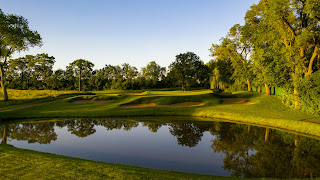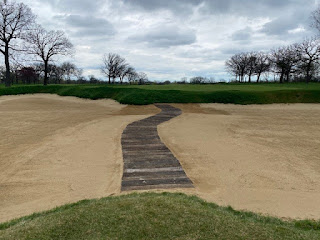Its been a busy season to say the least in 2021. I wanted to give an update on the course construction projects and what to expect moving forward with fescue.
Short Course
There has been a lot of excitement in the air as many could see the construction of the 3 hole Short Course take shape over the last 3 months. It began as a difficult project to manage as we were constantly being hit with set backs. Equipment breakdowns and major weather issues plagued the project early on. However, as the weather cleared and we were able to get a couple of good weeks the Short Course took shape quickly. The majority of the project was done "in house" by our staff with help from Architect Tyler Rae and his team.
The area was seeded and sodded on August 9th and 10th. Although we did have a heavy thunderstorm come through post seed, much of the seed stayed put and we were able to get a nice catch overall. We saw our first bit of bent grass seed germinate on the Greens and Fairway a week after seeding. Due to the heavy rain there will be some minor areas we will have to tweak with some extra seed and sod work.
The area consists of 4 greens- One Green dedicated as a Putting Green and the other 3 Greens as the 3 hole loop. There are 8 bunkers in the short course area- 7 Greenside bunkers and a "wishbone" fairway bunker cut into the hill side in the center of the complex. The yardages range from 65-155 yds depending on the different shots, angles and loops taken throughout the facility.
Overall, I'm very pleased with what we are seeing in terms of seed germination. Look for the first mow on the area in the coming weeks! Its gonna be a great addition to the landscape here at Beverly CC!
Short Game/Himalayan Putting Green
Now that the Short Course has been seeded, we have shifted focus on the new Short Game/Himalayan Putting Green next to the clubhouse. Due to the setbacks we experienced on the Short Course, we were slightly behind schedule on our ground breaking date for the Short Game area. We broke ground on August 16th, however, with the good weather we have received, we are beginning to get back on schedule. You can see the area take shape as we have spent the past few weeks removing existing irrigation/drains, moving dirt and constructing the new Green complex and Himalayan Putting Green. We cut into the East parking lot helping to create 10,000sqft of new hitting turf. Overall, the new design gives the Short Game area an additional 22,000sqft of hitting space vs the old design. The fence line separating the parking lot and short game area will be reinstalled along with shrubs and cover to isolate the parking lot from the short game area as well as help protect cars from any errant shots.
Truckloads of clay will begin being hauled into the old pool area to build up the base of the new Himalayan Putting Green. This will bring sporadic closures to the East parking lot as we try to maneuver the large trucks into place. This green is sized at +20,000sqft which will give plenty of space for a fun unique putting course!
As with the short course project, the majority of this project is being done in house along with Tyler Rae and his team. Our focus on the grounds department will be on getting this work done as quickly as possible in hopes to have it seeded by end of September first of October. This short game will be a very unique complex for Beverly. The Himalayan Putting Green will see great use for post round fun, drinks and I'm sure a few friendly wagers!
Fescue
Part of the overall masterplan implemented in 2019 was the addition of fescue to the golf course. Fescue can be a hot topic and usually consists of many different opinions when used on a golf course. I want to discuss what the goal of our fescue will be and help the membership understand the expectations of growing the fescue properly.
Golf Course Architect, Tyler Rae, walked the course identifying areas to seed to fescue. He mapped out roughly 15 acres of area throughout the golf course to be turned to fescue. Some of these areas were obvious, like behind #6 Green, other areas maybe not as obvious. Tyler's goal was to slowly introduce fescue strategically throughout the course but not to over run the golf course. He chose areas that gave great aesthetic value in breaking up the landscape as well as areas where it can come into play and keep golfers on their toes. Our fescue lines are very forgiving in most areas, meaning Tyler kept the majority of the fescue roughly 30yds from the fairway. This gives plenty of landing room in the rough to act as a buffer before a ball would find the fescue. The overall goal of the implementation of fescue is NOT to overwhelm the golfer, slow pace of play or to ruin the golf experience at Beverly. The goal is to add aesthetic value to the golf course, create thin, wispy, playable fescue that challenges golfers in a few spots and help enhance the golfing experience at Beverly.
What is the process and the expectations of growing fescue in on a golf course? In a two word answer- slow and ugly! To properly get the fescue right and meet our goals of thin, wispy, playable fescue- less is more. Its important to remember that it is a 3 year process to get it right. The areas will look ugly at times, even bare and muddy in spots as we slowly grow the fescue. One of the major drawbacks of fescue is the areas becoming over grown, thick and unplayable. This tends to happen when the fescue is rushed to grow and fill in. It becomes overly healthy and thickens too much too fast. We want to take it slow, use low seed rates and let mother nature do its thing with rains, etc.
We have already started the process and have killed the areas identified by Tyler. It will take 3 applications of round-up to properly get a full kill of the turf. The 3 apps will help make sure we have killed all existing turf and anything that may have tried to reestablish quickly.


































